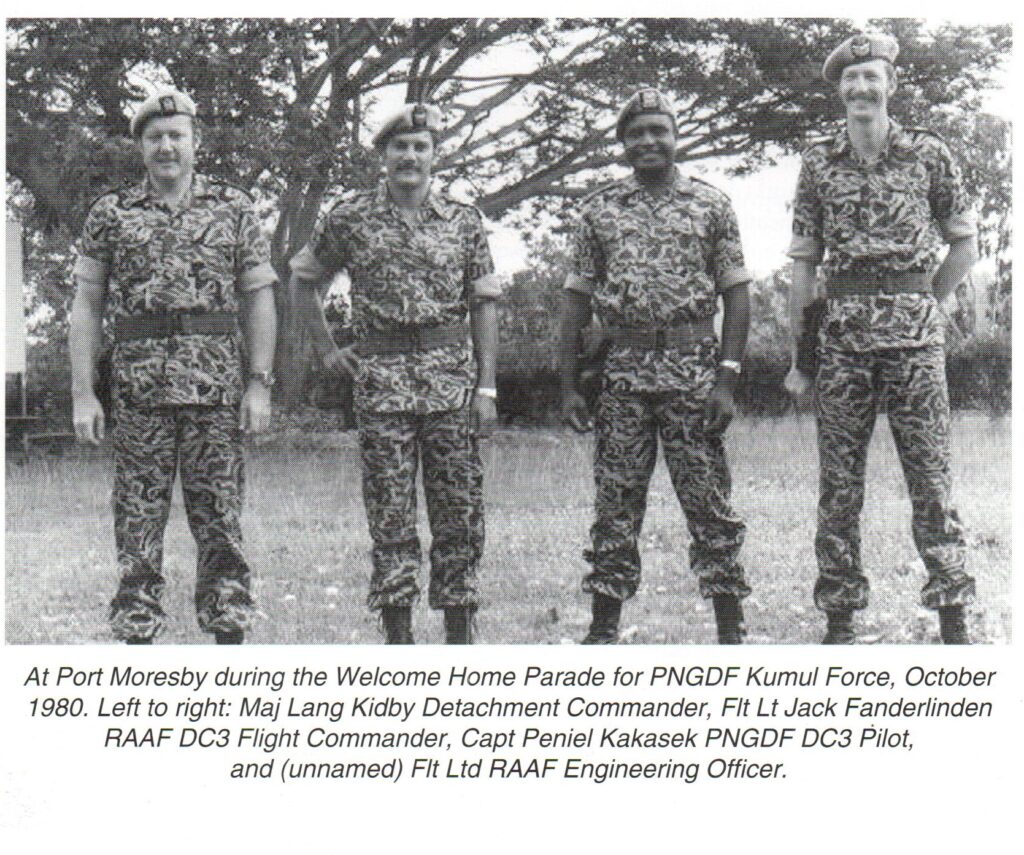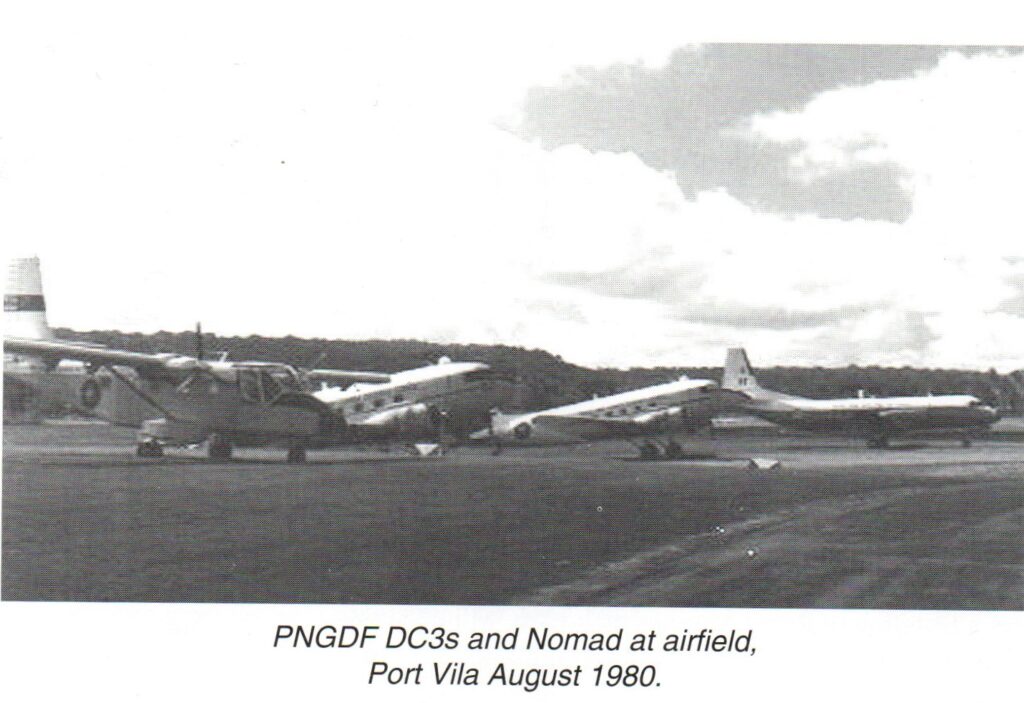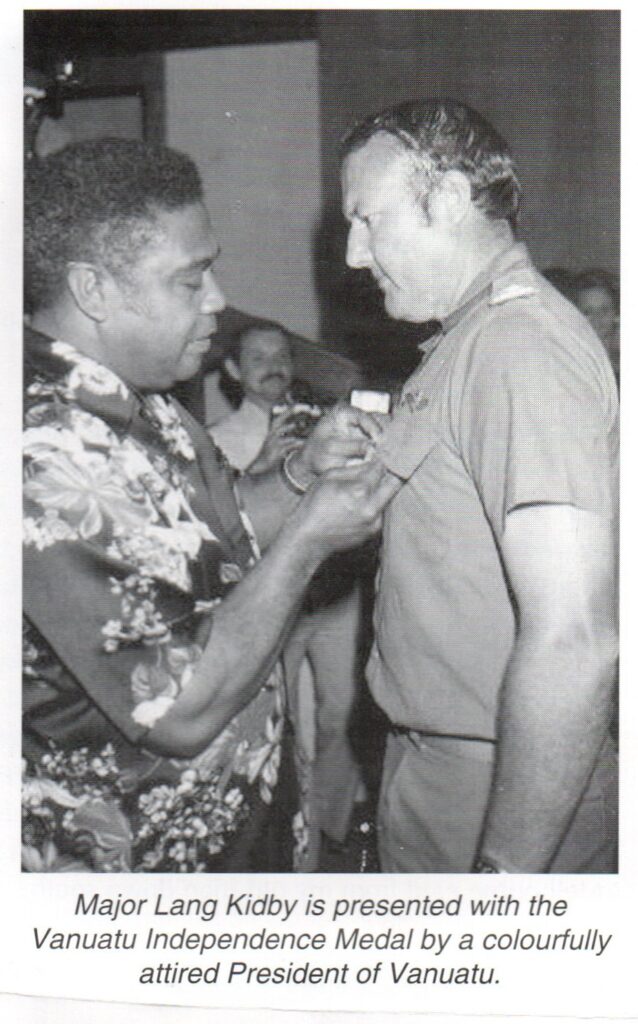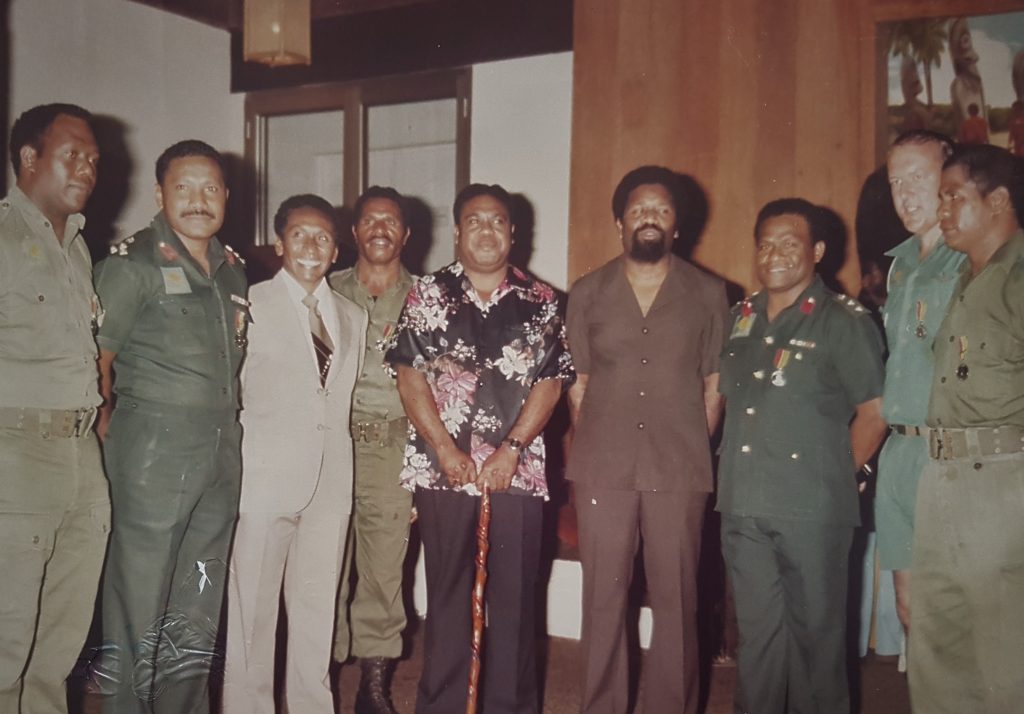
During 1980, as Ops Officer/2IC of the Papua New Guinea Defence Force, Air Transport Squadron, I had the pleasure of commanding the air element of the force sent to Vanuatu to suppress the rebel forces attempting to disrupt an orderly transition to independence from the combined French/British colonial government.
Our detachment of two DC 3s and one Nomad with supporting ground crews arrived about a week before independence in order to participate in the celebrations. We were then to support a full battalion plus two companies of the PNGDF in military operations. At this time, half a battalion of Royal Marines sat on the airfield at Espiritu Santo, merely keeping it open and unwilling to take any action against the reasonably well organized rebel force which controlled the island. They looked across the runway at half a battalion of French Foreign Legion Paras with their crew cuts and tight camouflage uniforms. The political situation was such that fighting between these two groups was more likely than against the rebels.
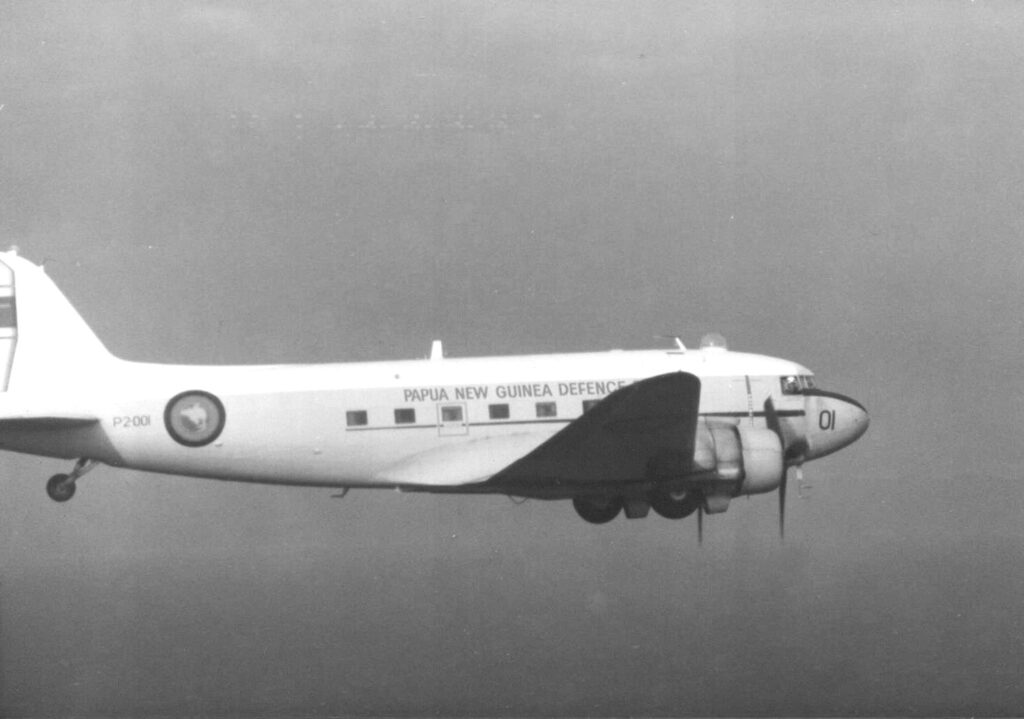
The ridiculous system of government that existed in the New Hebrides of joint control by Britain and France led to a build up of friction among the local population. Two Police Forces, two school systems, two hospitals. The British, naturally, had developed control of the Public Service while the French were dominant in the commercial area such as plantations. It was the French-leaning planters who were aiding the rebels to resist a smooth transition to independence.
The large Independence celebrations were to be attended by military contingents from Australia, New Zealand, Fiji, PNG and others. The stars of the big parade were, of course, the Royal Marines and the Foreign Legion. Discussions, more involved than any arbitration court hearing, were undertaken. The French refused to march to a British band, the British refused to march to a French band and they both refused to march to a neutral Fijian band. They did agree to have exactly 200 troops each on parade.
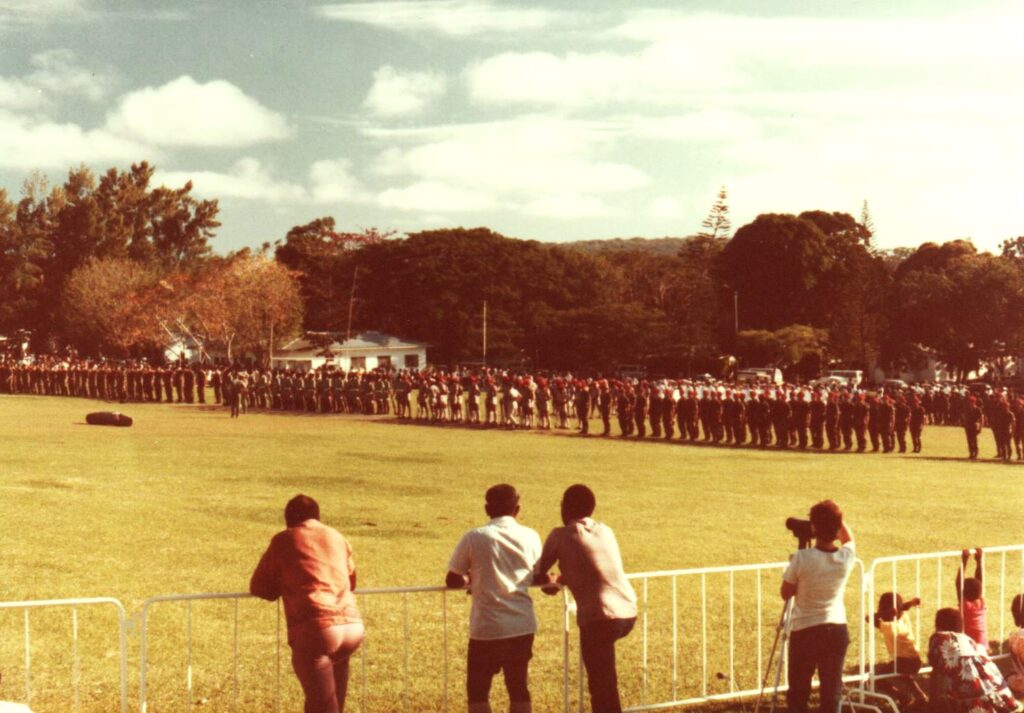
I went down to have a look at the dress rehearsal and saw the Marines march briskly on to “The British Grenadier”. Simultaneously from the other side of the parade ground, so neither team would be first, came the Foreign Legion initially to a bugle band then reverted to their very impressive and intimidating silent ¾ pace, slapping their thighs with each step.
Just as “right dress” had been performed twice by respective RSM’s (they could not agree to have one parade commander) a cry went up from the French colonel, who was co-commander of the parade. This was followed by the two RSM’s changing sides and doing a head count of the opposition. The British had sneaked on an extra man! The British RSM rushed over to a poor private soldier, obviously picked at random from the ranks, and began a face-saving tirade against the innocent kid for having crept on parade, unauthorized. French – 1, British – 0.
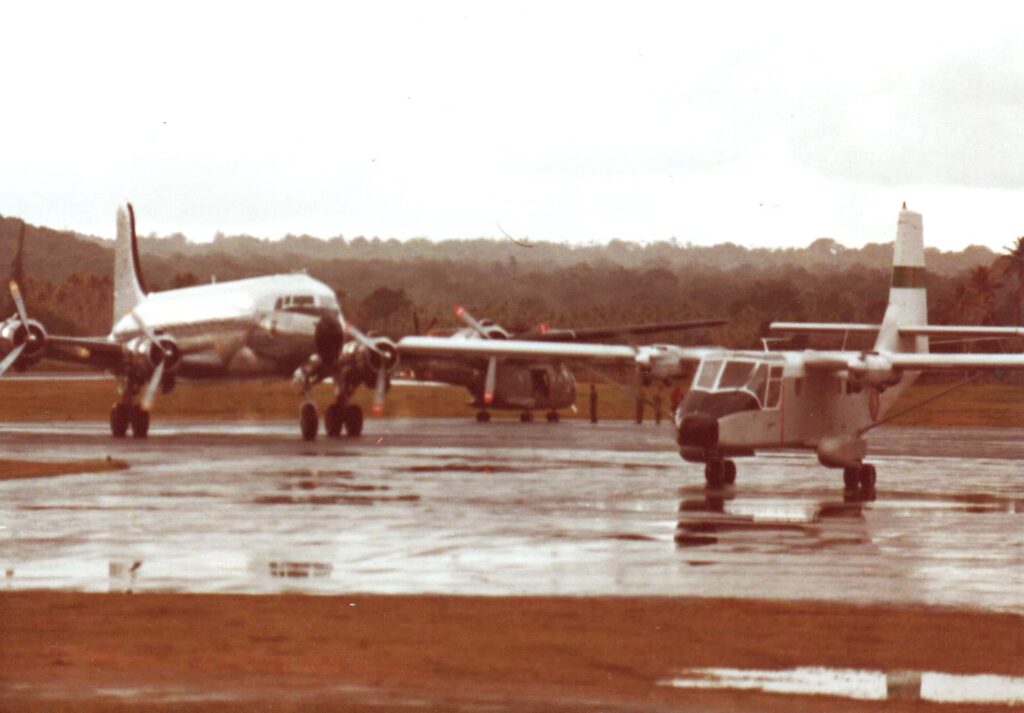
Early next morning, on the day of the parade, aircrews met for the formation planning and briefing. Present were a French Marine Major in charge of four large Puma helicopters, a British RAF Wing Commander leading three C – 130 Hercules and myself with the two DC 3s and the Nomad. An Australian RAAF Orion was to join in for the flypast but would be coming from Australia and returning without landing.
Much discussion followed between the French and British about who would be first, who would be lowest etc. The bidding reached treetop height without resolving the leadership so a simultaneous overhead time 500 feet apart was agreed upon. The French got the bottom level only because the helicopters could climb out of the amphitheater of the parade ground at such a low level better than the C 130s.
I went out to the airfield to brief the captains of the DC 3s – Captain Peniel Kakasek, a PNG pilot was put safely at number one. Flight Lieutenant Jack Fanderlinden, our RAAF PNGDF Flight Commander, was positioned abreast of him while I took up a place in the Nomad tucked up between the two DC 3s doing the radio work. We had not been involved in the altitude auction and were set at 1,500 feet and, of course, bringing up the rear.
A racetrack holding pattern was set up over a nearby bay, out of sight of the spectators. Only to be expected, there was both a British and French pilot stationed at the parade ground with separate radios, on the same frequency, calling the parade timings for us. Both controllers were giving commentary in their own language with maximum use of jargon and slang.
The Pumas were holding at 500 feet, the Hercules with the Australian Orion attached were at 1,000 feet and the Nomad/DC 3 combination at 1,500 feet. From my vantage point I could see both lower teams jockeying for position and cutting the corner to keep each other covered like an Americas Cup yacht race. As we turned onto the outbound leg of the pattern I looked up and saw that the Pumas had climbed to our level and were coming straight towards us. With still two minutes to go to commence run-in, the onrushing Pumas pushed their noses down and rocketed underneath us. A cry went up from the Hercules, who were travelling in the opposite direction, “Those bloody Frogs have got away!”
Suddenly, black smoke poured from 12 big turbines and I swear I saw wingtip vortices coming from the strain of what looked like a formation turn at 90 degrees of bank. The Australian Orion was squealing about stalling and pleading for bank reduction but British honour was at stake. Meanwhile the French major was demonstrating retreating blade stall to his pilots and, no doubt, seeing the effect of the needle passing the red line on their air speed indicators.
I don’t know what the ground controllers thought when, after calling “Two minutes/Deux minuit”, they looked up and saw eight rapidly growing specks, shrouded in black smoke, heading for the parade ground.
The timing was immaculate! Just as the new President was reaching the high point of his speech, the Pumas hit the parade ground at something like 150 knots only about 100 feet off the ground. At exactly the same time the three Hercules arrived, with the Orion hanging on like grim death, less than 500 feet above the helicopters at something like 300 knots.
Screaming children and fainting women were being attended to by the time our little group flew sedately past and many thought we were the only aircraft following on from the unexplained atomic explosion of a minute previously. Most people were so disoriented that they failed to see Jack Fanderlinden pruning the trees behind the parade ground when he underestimated the height of the hills during his graceful right break.
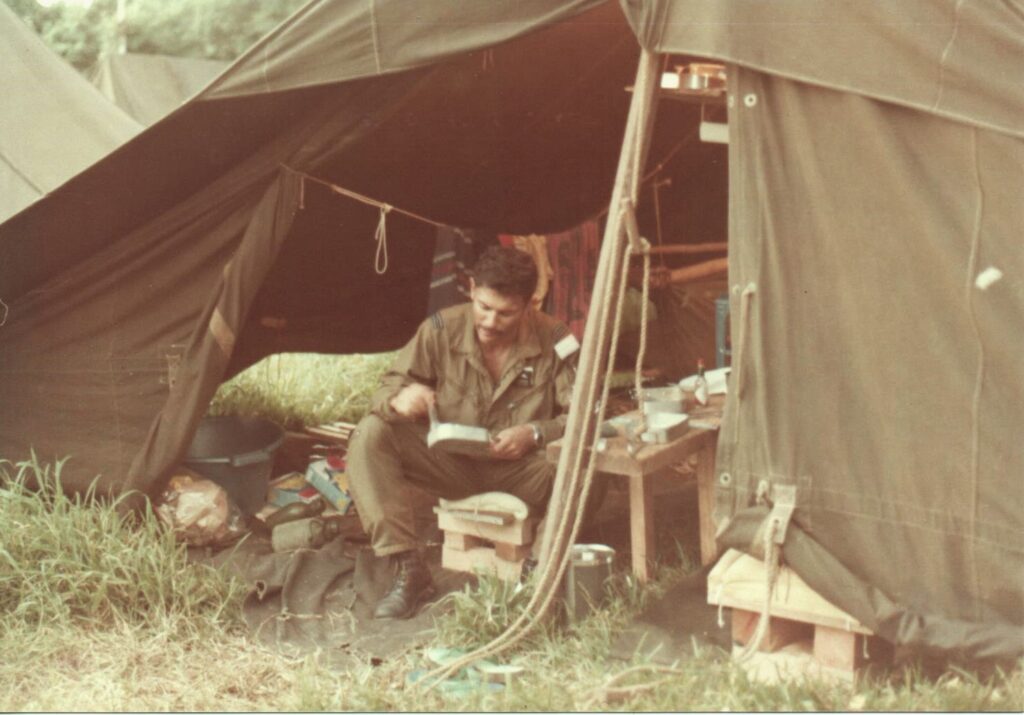
The following morning the new nation of Vanuatu was on the map. We commenced ferrying the PNGDF troops to Santo to replace the French and British who were leaving as fast as they could. The PNG force immediately went into action against the rebels resulting in a number of fierce firefights and casualties on both sides. Many prisoners were captured in the initial operation. These prisoners, both native people and French planters, were taken back to Vila in our aircraft for trial and imprisonment (they all asked to go to the French jail because wine was served with meals there).
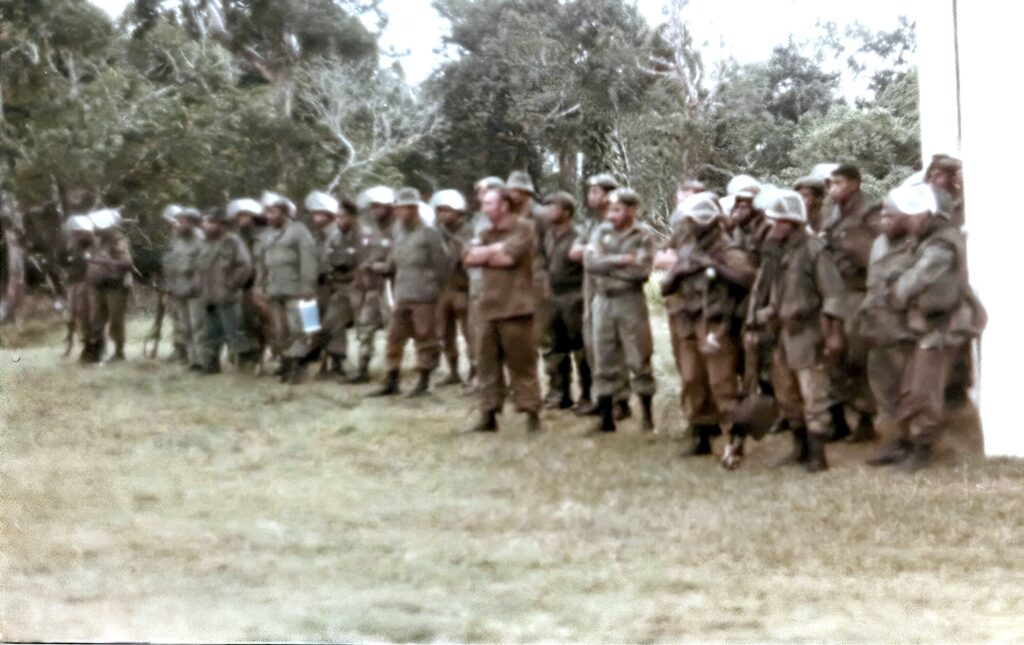
Some very nasty scenes occurred at the airport when the police settled old scores. The prisoners, with their hands tied behind their backs, were thrown the two metres out of the DC3 doors then made to run a gauntlet of pounding truncheons to the paddy-wagons – all in front of the world press. I had a few worrying moments trying to convince the excited Chief of Police that they would not have our aircraft unless they chose to settle their scores in a more private place.
A short while after the war commenced, Captain Leigh Collins arrived from Oakey after an heroic over water flight with two Pilatus Porters. His role as the Australian Army Aviation senior officer and chain of command through the local Australian High Commissioner in Vila as opposed to my role as PNGDF aviation senior officer with a chain of command through the Australian High Commissioner in Port Moresby was interesting.
It led to petty politics and nearly to direct orders not to tell each other what we were doing – but to “co-operate!” Leigh and I were very good mates and had served in the same unit for several years previously so such pettifogging did little to dampen our close co-operation. In any case, Leigh and his boys did a marvellous job every night on long overwater flights surrounded by thunderstorms and the information he provided with his magic boxes helped us greatly.
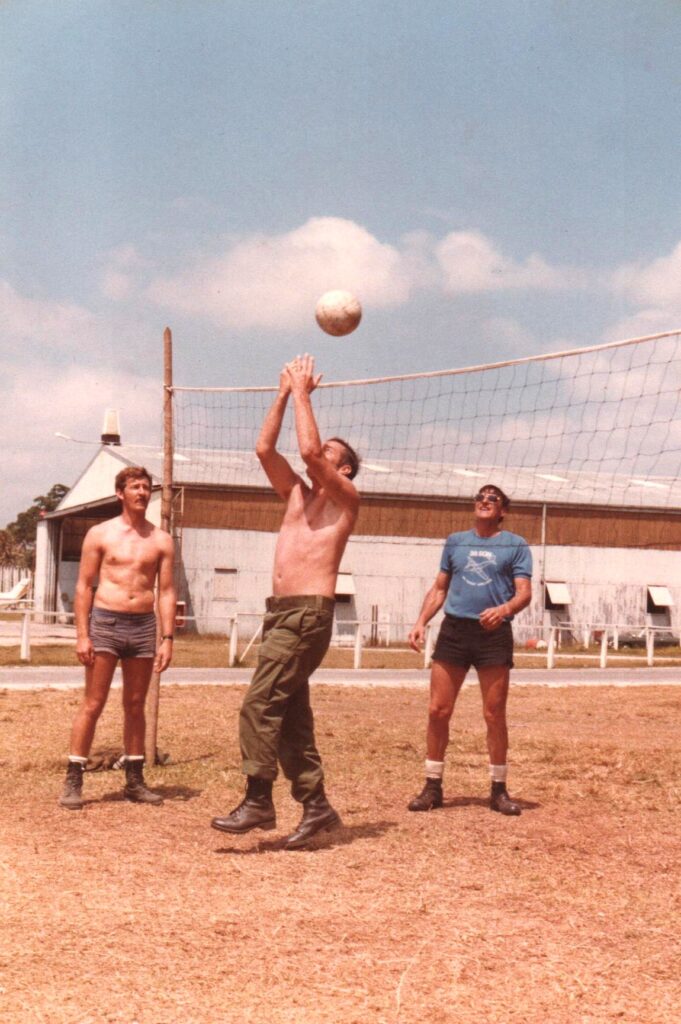
We transferred to Santo from Vila a couple of weeks after the start of operations to give close support to the infantry. The three planes were doing about 45 hours per week each and, with only one crew per plane, we thought we were earning our keep. The ground crew performed miracles to keep all aircraft, particularly the DC3’s, on line for the whole period.
The job was made more interesting with night runs to Vila in heavy tropical rain having to do a tight curving strobe light approach in zero visibility. The fellows in the DC3s and Porters didn’t even have the luxury of radar, which I had in the Nomad.
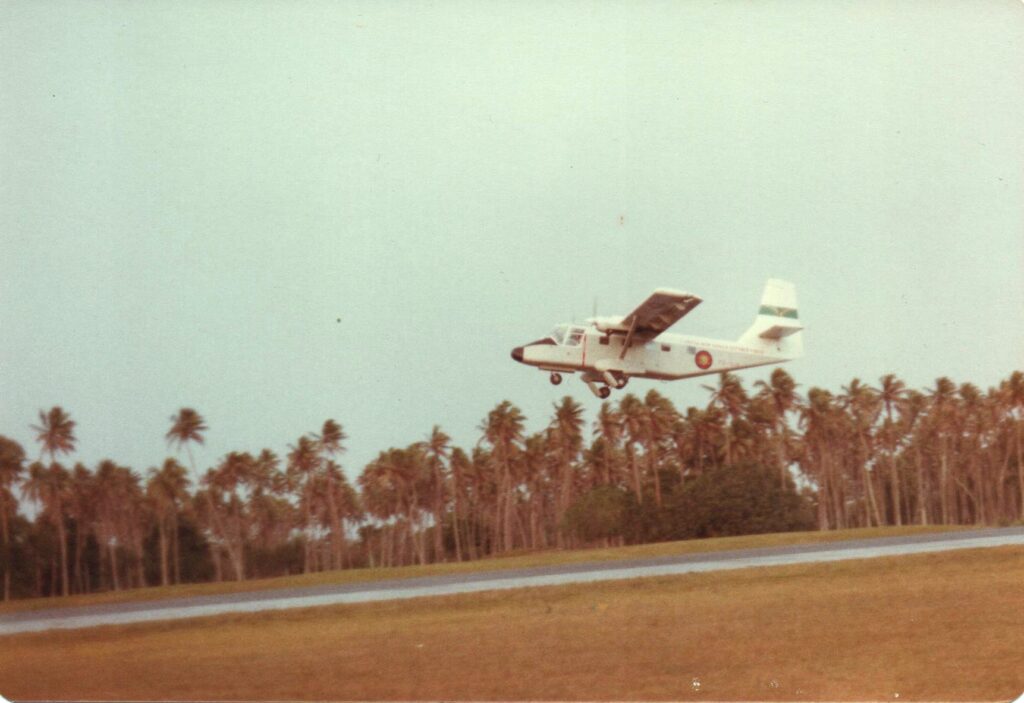
After a couple of months, Jimmy Steven’s, rebels had been forced to the north of Espiritu Santo. They were held by a blocking force of two companies of PNGDF troops supported by Vanuatu para-military police. The main battalion was to make an amphibious assault using three LCM-8 landing barges, which had sailed across from PNG with a patrol boat escort.
The planning was something to dwarf D-Day. The battalion did dress rehearsals and the Nomad did numerous photographic and reconnaissance runs along the landing beach and of enemy positions. My CO Geoff Wood arrived from PNG in the daily Learjet courier to give me a two week break (which was a waste of time because I had to do a 10 day job in the New Guinea highlands before returning to Vanuatu.
The Brigadier decided he needed tactical air support and, the legalities being a little hazy, I had conceded to design a mount in the door of the Nomad for an M-60 machine gun on a tripod.
An hour before dawn on D-Day, the Brigadier waited at the Nomad for the gunner to arrive (it later transpired he slept in and missed the war) and when nobody came, set off to control the assault. Right on dawn, the invasion force turned from line-astern to sweep into the beach, while the patrol boat used its main armament to soften up the enemy positions. The single Bofors gun did punishing work to a coconut tree and two sand crabs.
As the barges dropped their ramps, the infantry charged forward, leaving a couple of wounded on the beach. A close run to point out an enemy position was going well until the skipper of the patrol boat decided to assist. Just as the aircraft swooped down on the tree line, the top of a coconut tree directly under the Nomad exploded, causing an immediate gain in height and caution. After this, directions reverted to “Reference, large bushy tree….” from a respectable distance.
The only casualties suffered by the good guys in the initial assault were the two lying on the beach – both shot with the same bullet through the leg by one of their excited mates behind them on the barge. Some interesting small battles followed and eventually the rebellion was suppressed and the last opposition rounded up.
After handing over to the Vanuatu para-military police to restore normal security, the PNGDF “Kumul Force” returned home.
